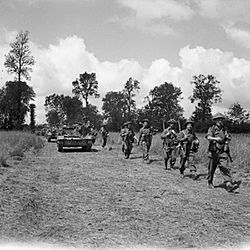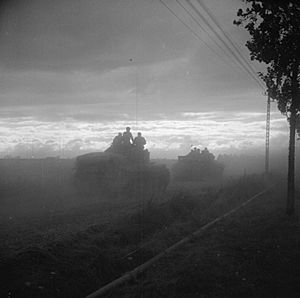Operation Bluecoat facts for kids
Quick facts for kids Operation Bluecoat |
|||||||
|---|---|---|---|---|---|---|---|
| Part of Operation Overlord, the Battle of Normandy | |||||||
 Universal carriers and infantry of the 15th (Scottish) Infantry Division move forward during Operation Bluecoat, 30 July 1944. |
|||||||
|
|||||||
| Belligerents | |||||||
| Commanders and leaders | |||||||
| Strength | |||||||
| 3 armoured divisions 3 infantry divisions 2 armoured brigades +700 tanks |
rising to: 4 panzer divisions 2 infantry divisions |
||||||
| Casualties and losses | |||||||
| 5,114 (VIII Corps only) 246 tanks (excluding light casualties) |
+100 tanks (including light casualties) | ||||||
Operation Bluecoat was a major attack by the British Army during the Second World War. It took place in Normandy, France, from July 30 to August 7, 1944. This operation was part of the larger Operation Overlord, also known as the Battle of Normandy.
The main goals for the British forces were to capture the important road junction town of Vire. They also wanted to take control of the high ground around Mont Pinçon. This area was important for controlling the surrounding land. The attack was led by the British Second Army, commanded by Miles Dempsey.
The British launched Operation Bluecoat quickly. They wanted to help the First US Army after its successful breakout in Operation Cobra. The Germans had moved some of their strong tank units away from the British front. This was to use them against the Americans. The British saw this as a chance to attack.
Contents
Why Did Operation Bluecoat Happen?
From July 18 to 20, the British Second Army had carried out Operation Goodwood. This attack was near Caen and had forced the Germans to keep most of their tanks in that area. After Operation Goodwood, the Allies learned something important. Secret messages showed that the Germans planned to move a tank division to the American side of the front.
On July 25, the American forces began Operation Cobra. This was a huge attack to break out of the Normandy area. The British attack, Operation Bluecoat, was planned to support this American effort. It would keep German tanks busy on the British front.
Getting Ready for Battle
British Preparations
The line between the British and American armies was moved. This meant the British took over an area where German infantry were dug in. These German soldiers were not heavily armed. This gave the British a good chance to launch a new attack. The goal was to keep German tanks tied down in the British sector.
Three British armoured divisions were moved to the west. These were the 7th, 11th, and Guards Armoured divisions. They were placed near Caumont. General Dempsey had planned the attack for August 2. But events moved faster than expected. So, he had to start the operation earlier.
German Defenses
The Germans had pulled back their 2nd Panzer Division from the Caumont area. They replaced it with the 326th Infantry Division. This division was at full strength. It took over a 16-kilometer (10-mile) front. The Germans had many strong defenses. These included hidden firing positions and large minefields. The area itself, called the Suisse Normande, had thick hedges and deep gullies. This made it a very good place for defense.
The Attack Plan
The British XXX Corps was to lead the attack. The 43rd (Wessex) Infantry Division would advance to a high point called Bois du Homme. The 50th (Northumbrian) Infantry Division would protect their left side. The 7th Armoured Division was kept in reserve.
On the right side, the VIII Corps would protect the western flank. The 15th (Scottish) Infantry Division would attack south from Caumont. The 11th Armoured Division would attack across the countryside further west. They were ready to push forward if the German defenses broke. More than 1,000 bombers were used to prepare the way. They dropped bombs instead of using artillery.
The Battle Begins
The weather was foggy, but the bombers hit their targets accurately. They dropped 2,000 tons of bombs. The damage to German equipment was not great. This was because there wasn't much German equipment in the bombing areas. Some British units were held back by minefields and difficult terrain. But in the center, the attackers moved forward about 8 kilometers (5 miles).
On July 31, the 11th Armoured Division found a weakness in the German lines. They discovered an undefended bridge over the River Souleuvre. This bridge was 8 kilometers (5 miles) behind the German front. They quickly sent Cromwell tanks and other support units across it. This broke up the first German tank units sent to counter-attack.
By August 2, British forces were about 8 kilometers (5 miles) from Vire. This town was actually on the American side of the army boundary. There was some confusion about which army could use certain roads. The British attack was limited and sent in a different direction. The Germans were able to send more troops to Vire. These included parts of the 3rd Parachute Division and the 9th SS Panzer Division. They tried to close the gap in their lines.
The German reinforcements slowed the British advance. The VIII Corps also had to protect its eastern side. This was because the XXX Corps had not advanced as quickly. The commander of XXX Corps, Gerard Bucknall, was replaced on August 2. The commander of the 7th Armoured Division was also replaced. Brian Horrocks, a very experienced general, took over XXX Corps on August 4.
The British Second Army's advance stopped for a short time on August 4. Vire was captured by American forces on August 6. On the same day, the British 43rd (Wessex) Division and tanks captured Mont Pinçon. This was a key high point.
What Happened Next?
Soldier Losses
During Operation Bluecoat and later battles in Normandy, the VIII Corps had 5,114 soldiers killed, wounded, or missing.
Later Operations
Operation Grouse
By August 9, the Allies knew that a German counter-attack against the Americans had failed. The British planned a new attack called Operation Grouse. The goal was to keep the Germans busy or cause their defenses to collapse. The 3rd Division would advance around Vire. The Guards Armoured Division would move down Perrier Ridge. The VIII Corps aimed to take high ground near Tinchebray and Condé-sur-Noireau.
The attack was planned for August 11. But a thick mist that morning prevented the bombing. It also made the tank and infantry attack disorganized. German fire limited the advance on the eastern side. In the center, British soldiers found three German Panther tanks in a farmyard. They ambushed them, destroying two. The British continued to advance towards Point 242. Here, a German counter-attack destroyed six British Sherman tanks.
On the western side, British troops made faster progress. They reached the west side of Chênedollé. When they attacked the village, they found the German soldiers had already left. The bombing had not happened, so the British secured the village. Further attacks were delayed and then canceled.
The British advance on the right side began at 9:00 a.m. They moved south through Viessoix and Le Broulay. Then they aimed for Moncy, and finally to Point 260 on Mont de Cerisi. German resistance was very strong. Minefields and fire from the 3rd Parachute Division stopped the advance. In the afternoon, an attempt to go around to the east was also blocked. The advance had only covered 800 meters (875 yards) in five hours. With the attack stuck, the troops were pulled back. New orders were given to hold the Vire–Vassy road.
|




